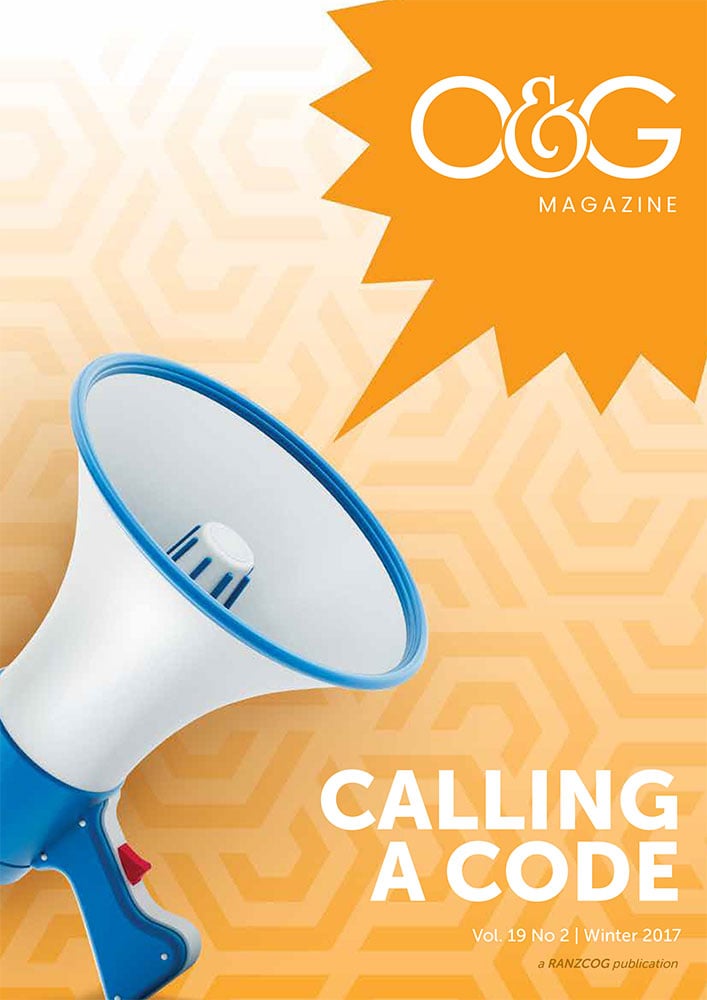By the time these pages reach you as readers, both the first and second issues of ANZJOG 2017, in the new format and colour, should be with you.
The February issue kicked off with an interesting Editorial by Rosalie Grivell and Amanda Poprzeczny: ‘Obstetrics: Hoping for the best, preparing for the worst. Forewarned is forearmed’,1 which complemented a paper from New Zealand by Bird et al on maternal health in pregnancy and associations with adverse pregnancy outcomes. The Bird paper is based on part of the prospective study, Growing Up In New Zealand, in which 6822 women were interviewed in the last trimester of pregnancy about their health before and during pregnancy, and their information linked to perinatal medical records including socio-demographic information.2 The study provides vital information about quantifying the degree of morbidity chronic health conditions prior to and during pregnancy contribute to adverse pregnancy outcomes, while pregnancy itself, as the authors of the editorial describe very accurately, provides its own ‘unique and short-lived’ risks of morbidity and mortality.
National assisted reproductive technology (ART) standards in clinics across Australia and New Zealand are continuing to improve and risks of ART treatments to reduce, according to a recent review of clinics reported by Harrison et al.3 Clinics in both countries are accredited and licensed against a Code of Practice consisting of 15 Critical Criteria. This system, the Joint Accreditation System for Australia and New Zealand, is administered by the Reproductive Technology Accreditation Committee (RTAC) of the Fertility Society of Australia. The incidence of clinics with variances against the Critical Criteria decreased from 77 per cent to 14 per cent from 2011 to 2013, and the mean number of variances per clinic fell from 1.54 to 0.14. All of which should be of interest to our specialist and generalist readers alike.
Other Original Articles on obstetrics deal with aspects of induction of labour, antenatal corticosteroid administration practice, and a paper dealing with the antenatal prediction of the rare but important condition of gastroschisis.4 5 6 7
The topic of micronised progesterone, available to Australian women since September 2016, is the subject of the short Review by Eden8 looking at endometrial and breast safety of this product when used with oestrogens as part of menopausal hormone therapy. The author’s conclusions are largely positive, although he cautions that more research is required, ‘ideally a large RCT.’
In the gynaecological Original Articles, Ma et al present the results of an 11-year prospective study showing that outpatient hysteroscopy, widely practised in some overseas centres but less so in Australia to date, is ‘safe, effective and acceptable to women.’9 Successful hysteroscopic access was achieved in 94 per cent of 990 women. The authors point to the considerable savings potentially available if more hysteroscopy in Australia were to be provided as an outpatient, rather than inpatient, service. Elsewhere, Young et al discuss the need for further services for the provision of psychosocial care for women with endometriosis,10 and Suisted and Chittenden demonstrate good outcomes for total laparoscopic hysterectomy in a regional hospital setting.11
ANZJOG’s Sexual and Reproductive Health section is now well established. In this issue, Black et al present more evidence for the growing use of medical management of early miscarriage, which enables many women to avoid surgical evacuation,12 while Perriera et al explore the implications of placenta praevia for the management of women undergoing second trimester termination of pregnancy.13 Not unexpectedly, they found increased risks of haemorrhage, on occasion requiring transfusion. While this study comes from a centre practising only surgical second trimester procedures, these findings would have similar implications for medical termination of pregnancy.
The second in the newly established series of Current Controversies in Obstetrics and Gynaecology, which can be briefly summarised as ‘the mesh debate’, can be found in the February Opinion pages, where Wong and Shek argue strongly that ‘Transvaginal anterior anchored mesh should not be abandoned.’14Mowat and Maher counter with ‘Let’s not repeat the mistakes of the past.’15 Both sets of authors provide thoughtful, well-referenced, evidence-based arguments that should be of great interest to much of our readership. The authors have also written replies to their opposite numbers, which appear in the April issue of ANZJOG.‘16 17 Further topics planned for the Controversies series include elective vaginal breech delivery, and the place of robotics in gynaecological surgery. ANZJOG has received a number of Letters to the Editor on the recent Controversies topics, which will start to appear from the June issue of ANZJOG onwards.
The April issue begins with the print version of the outstanding Ian MacDonald Oration delivered by Prof John Newnham at the RANZCOG ASM in Perth in October 2016, ‘The whole nine months last a lifetime.’18 For those readers who were not at the ASM, this is the chance to catch up on some of the latest developments in maternal-fetal medicine (MFM) and particularly on preterm birth prevention; for those who were there, it is the opportunity to reflect again on the advances and challenges of this important area of perinatal medicine. A related opinion piece by Pedretti et al from Prof Newnham’s department in Perth supports the universal application of cervical length screening during midtrimester ultrasound scanning for all pregnant women, not only those at high risk of preterm labour.19
More about the April issue, filled with interesting articles in all categories, will appear in the next issue of O&G Magazine. We continue, happily, to receive large numbers of submissions to ANZJOG, many of a very high standard and the majority of which go for peer review, so more peer reviewers are always welcome. Please contact Sarah Ortenzio at College House on [email protected] if you would like to join the list of reviewers.
The peer review process
ANZJOG aims to achieve a turnaround time for the first peer-review process of submissions of six weeks, that is, the time until a decision of accept, revise or reject is received by the authors. However, in practice this is not always possible. All submissions undergoing review are first referred to an associate editor (AE) (the editor-in-chief also acts as an AE). On occasion an AE may recommend rejection without review, but generally submissions are sent to two reviewers, who undertake the review process voluntarily. However, invited reviewers are not always available and it is not uncommon for six or more people to be invited before two suitable and willing reviewers agree to review. This may delay for several weeks the time until the manuscript reaches reviewers, who may then take several weeks until the review is returned. While a small number of manuscripts are either accepted or rejected at this point, most have some form of revision recommended and these recommendations are returned to the authors. Revised manuscripts then go through the same process, with the reservation that the original reviewers are not always willing to review the revision, in which case new reviewers must be found. For all these reasons turnaround time may well exceed six weeks; hopefully potential authors will be understanding of our limitations in this regard. And more reviewers are always welcome!
References
- Grivell R, Poprzeczny A. Obstetrics: Hoping for the best, preparing for the worst. Forewarned is forearmed. ANZJOG. 2017;57(1):10-11.
- Bird AL, Grant CC, Bandar, DK, et al. Maternal health in pregnancy and associations with adverse birth outcomes: Evidence from Growing Up in New Zealand. ANZJOG. 2017;57(1):16–24.
- Harrison K, Peek J, Chapman M, Bowman M. Continuous improvement in national ART standards by the RTAC accreditation system in Australia and New Zealand. ANZJOG. 2017;57(1):49-51.
- Zhao Y, Flatley C, Kumar S. Intrapartum intervention rates and perinatal outcomes following induction of labour compared to expectant management at term from an Australian perinatal centre. ANZJOG. 2017;57(1):40-8.
- Brown J, Beckmann M. Induction of labour using balloon catheter and prostaglandin gel. ANZJOG. 2017;57(1):68-73.
- McGoldrick EL, Brown JA, Groom KM, Crowther CA. Investigating antenatal corticosteroid clinical guideline practice at an organisational level. ANZJOG. 2017;57(1):25-32.
- Robertson, JA, Kimble RM, Stockton, K, Sekar R. Antenatal ultrasound features in fetuses with gastroschisis and its prediction in neonatal outcome. ANZJOG. 2017;57(1):52-6.
- Eden J. The endometrial and breast safety of menopausal hormone therapy containing micronised progesterone. ANZJOG. 2017;57(1):12-15.
- Ma T, Readman E, Hicks L, et al. Is outpatient hysteroscopy the new gold standard? Results from an 11 year prospective observational study. ANZJOG. 2017;57(1):78-80.
- Young K, Fisher J, Kirkman M. Clinicians’ perceptions of women’s experiences of endometriosis and of psychosocial care for endometriosis. ANZJOG. 2017;57(1):87-92.
- Suisted P, Chittenden B. Perioperative outcomes of total laparoscopic hysterectomy at a regional hospital in New Zealand. ANZJOG. 2017;57(1):81
- Black KI, de Vries, BS, Moses F, et al. The impact of introducing medical management on conservative and surgical management for early pregnancy miscarriage. ANZJOG. 2017;57(1):93-8.
- Perriera LK, Arslan AA, Masch R. Placenta praevia and the risk of adverse outcomes during second trimester abortion: A retrospective cohort study. ANZJOG. 2017;57(1):99-104.
- Wong V, Shek KL. The mesh debate: Transvaginal anterior anchored mesh should not be abandoned. ANZJOG. 2017;57(1):105-7.
- Mowat AE, Maher C. Transvaginal mesh: let’s not repeat the mistakes of the past. ANZJOG. 2017;57(1):108-10.
- Wong V, Shek K. Response to Transvaginal mesh – let’s not repeat the mistakes of the past. ANZJOG. 2017;57(2):219.
- Mowat AE, Maher C. Response to The mesh debate: Transvaginal anterior anchored mesh should not be abandoned. ANZJOG. 2017;57(2):220.
- Newnham JP. 2016 RANZCOG Ian McDonald Memorial Oration: ‘The whole nine months lasts a lifetime’. ANZJOG. 2017;57(2):134-8.
- Pedretti MK, Kazemier BM, Dickinson JE, Mol BWJ. Implementing universal cervical length screening in asymptomatic women with singleton pregnancies: challenges and opportunities. ANZJOG. 2017;57(2):221-7.






Leave a Reply